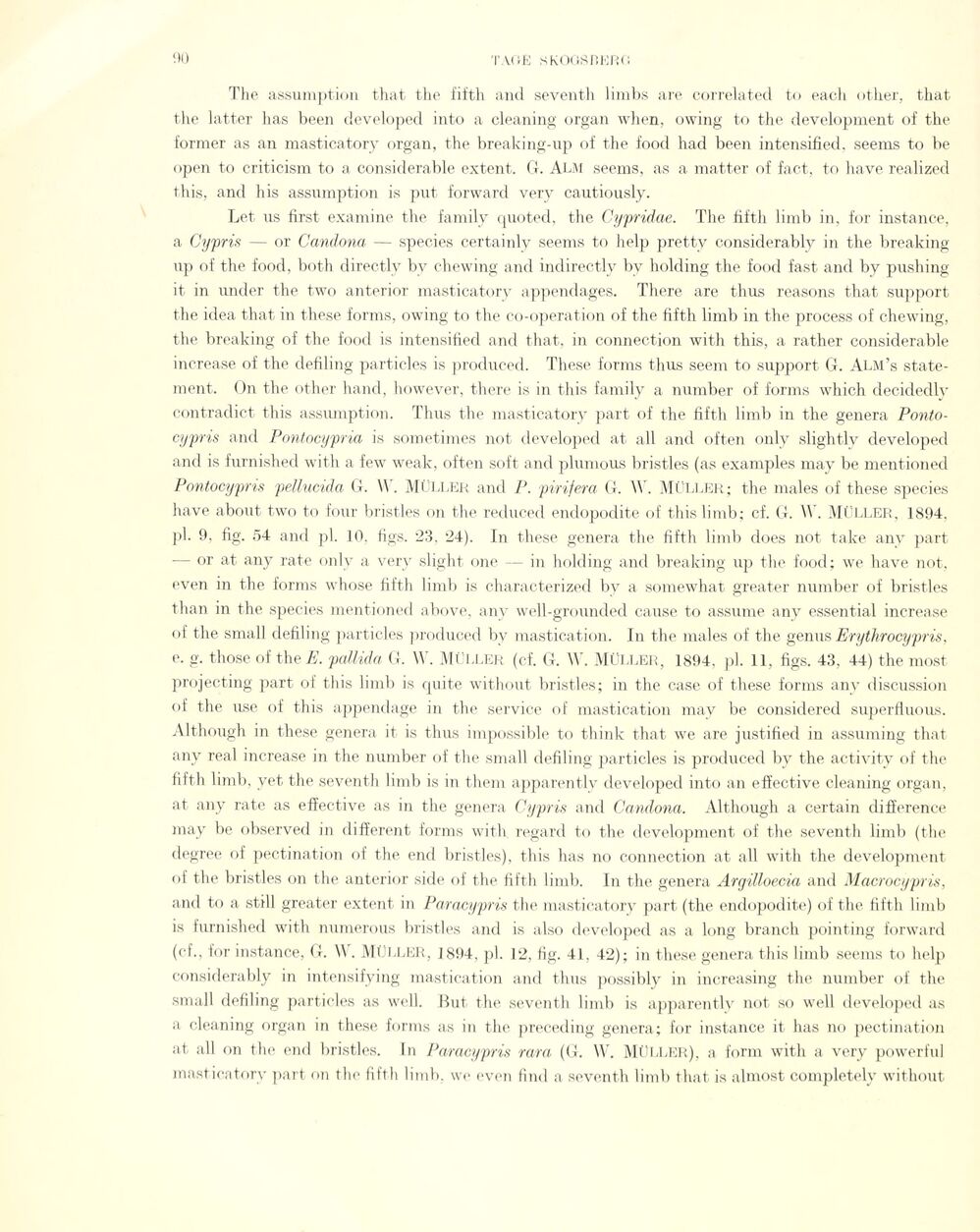
Full resolution (JPEG) - On this page / på denna sida - Sidor ...

<< prev. page << föreg. sida << >> nästa sida >> next page >>
Below is the raw OCR text
from the above scanned image.
Do you see an error? Proofread the page now!
Här nedan syns maskintolkade texten från faksimilbilden ovan.
Ser du något fel? Korrekturläs sidan nu!
This page has never been proofread. / Denna sida har aldrig korrekturlästs.
The assumption that tke fifth and seventh limbs are corrélated to eacli other, that
the latter has beeil developed into a cleaning organ when, owing to the development of the
former as an masticatory organ, the breaking-up of the food had been intensified, seems to be
open to criticism to a considérable extent. G. Alm seems, as a matter of faet, to have realized
this, and his assumption is put forward very cautiously.
Let us first examine the family quoted, the Cypridae. The fifth limb in, for instance,
a Cypris — or Candona — species certainly seems to help prettv considerably in the breaking
up of the food, both directly by chewing and indirectly by holding the food fast and by pusliing
it in under the two anterior masticatory appendages. There are thus reasons that support
the idea that in these forms, owing to the co-operation of the fifth limb in the process of chewing,
the breaking of the food is intensified and that, in connection with this, a rather considérable
increase of the defiling particles is produced. These forms thus seem to support G. Alm’s
statement. On the other hand, however, there is in this family a number of forms which decidedlv
contradict this assumption. Thus the masticatory part of the fifth limb in the genera
Ponto-cypris and Pontocypria is sometimes not developed at all and of ten only slightly developed
and is furnished with a few weak, often soft and plumous bristles (as examples may be mentioned
Pontocypris pellucida G. \V. MÜLLER and P. pirifera G. \V. MÜLLER; the males of these species
have about two to four bristles on the reduced endopodite of this limb: cf. G. W. MÜLLER, 1894.
pl. 9, fig. 54 and pl. 10. figs. 23, 24). In these genera the fifth limb does not take any part
— or at any rate only a very slight one — in holding and breaking up the food; we have not,
even in the forms whose fifth limb is characterized by a somewhat greater number of bristles
than in the species mentioned above, any well-grounded cause to assume any essential increase
of the small defiling particles produced by mastication. In the males of the genus Erythrocypris,
e. g. those of the E. pallida G. \Y. Müller (cf. G. \Y. Müller, 1894, pl. 11, figs. 43, 44) the most
projecting part of this limb is quite without bristles; in the case of these forms any discussion
of the use of this appendage in the service of mastication may be considered superfluous.
Although in these genera it is thus impossible to think that we are justified in assuming that
any real increase in the number of the small defiling particles is produced by the activity of the
fifth limb, vet the seventh limb is in them apparently developed into an effective cleaning organ,
at any rate as effective as in the genera Cypris and Candona. Although a certain difference
may be observed in different forms with. regard to the development of the seventh limb (the
degree of pectination of the end bristles), this has no connection at all with the development
of the bristles on the anterior side of the fifth limb. In the genera Argilloecia and Macrocypris,
and to a still greater extent in Paracypris the masticatory part (the endopodite) of the fifth limb
is furnished with mimerons bristles and is also developed as a long brauch pointing forward
(cf., for instance, G. \Y. MÜLLER, j894, pl. 12, fig. 41, 42); in these genera this limb seems to help
considerably in intensifying mastication and thus possibly in increasing the number of the
small defiling particles as well. But the seventh limb is apparently not so well developed as
a cleaning organ in these forms as in the preceding genera; for instance it has no pectination
at all on the end bristles. In Paracypris rara (G. \Y. MÜLLER), a form with a very powerful
masticatory part on the fifth limb. wo even find a seventh limb that is almost completely without
<< prev. page << föreg. sida << >> nästa sida >> next page >>